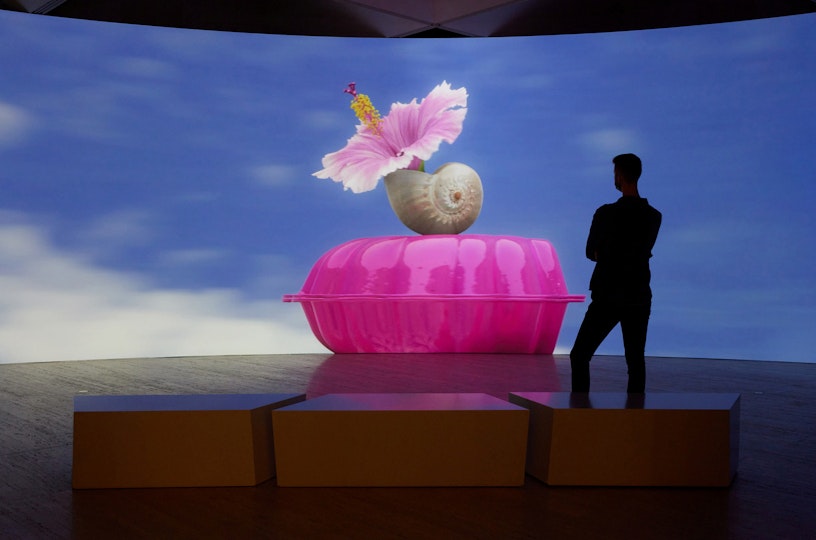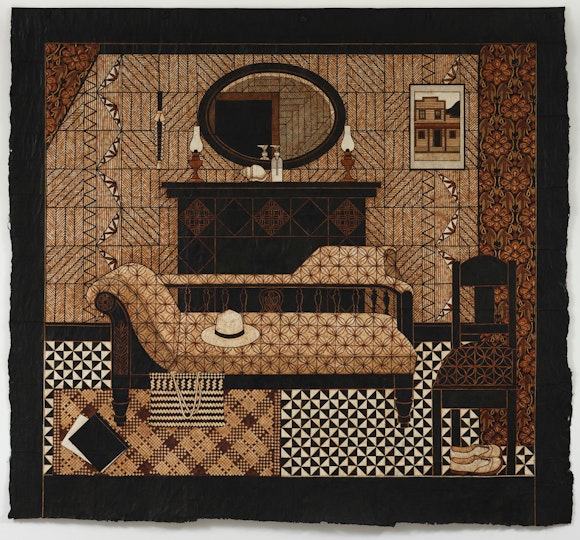Introducing Matisse Alive
From new commissions to collection highlights, Matisse Alive offers fresh perspectives on Henri Matisse (1869–1954), one of the world’s most beloved, innovative and influential artists.

Installation view of Angela Tiatia The pearl 2021 © Angela Tiatia
Matisse Alive curators Jackie Dunn and Justin Paton introduce audiences to this summer program, bursting with colour, held in conjunction with the major exhibition Matisse: Life & Spirit, Masterpieces from the Centre Pompidou, Paris.
What can visitors expect from Matisse Alive?
We’re hoping that the first things visitors encounter will be joy, life and colour. Our aim in staging Matisse Alive alongside Matisse: Life & Spirit is to feel Matisse alive in the building: alive, potent and as relevant to today’s artists as to our visitors. To that end, the entrance court will be filled with modern and contemporary abstract works from the collection, each revealing a profoundly vital approach to line and colour.

Installation view of Matisse Alive in the entrance court (left to right): Christine Streuli Smash it 2013, Gemma Smith Overshoot (Purple/Brown) 2013 and Michael Johnson Oceania high low 2014
Then, on lower level 2, another exhibition of collection works, Living Space, will explore the portrayal of domestic interiors and the lived spaces of home and studio that so fascinated and satisfied Matisse over decades of his practice.
On that floor, visitors will also encounter a display of bold tivaevae (Polynesian quilts, most often made by women) that sing with their simple designs and wildly contrasting colours. At the heart of Matisse Alive is a suite of commissioned solo projects by some of the most exciting women artists from around our region and across the world. One of those, New Zealand’s Dame Robin White, has also had a guiding hand in the creation of a fabulous making space designed for younger visitors and their families.
Since the main goal of my work is clarity of light, I asked myself, “What must it be like on the other side of the hemisphere?”

Henri Matisse in his studio cutting coloured gouaches, Nice, 1953; Henri Matisse and assistant, Hôtel Régina, Nice, 1952. Photos: Bibliothèque Kandinsky, MNAM-CCI, Centre Pompidou, Hélène Adant Collection
You mentioned traditional Polynesian quilts. What’s the relationship between these and Matisse?
Matisse was a great collector of fabrics. He grew up in the mill country of northern France surrounded by fabrics and started amassing a wide variety very early in his life, from Africa and Asia, as well as Europe. Tifaifai, as they are known in Tahiti, or tivaevae as they are known in the Cook Islands, made a big impact on Matisse during his Oceanic sojourn. He was surrounded by them – boldly patterned with simplified plant forms in vibrant colour combinations – in the house in which he stayed and, long after his return home, he recalled them in a direct influence on his own late cut-outs that follow a similar appliqué technique.
Our display of tivaevae has been offered to us by women from Sydney’s Cook Islands community, who continue expanding and refreshing this rich textile tradition today.

Tivaevae created by Sydney’s Cook Islands community on display in Matisse Alive

Tivaevae created by Sydney’s Cook Islands community on display in Matisse Alive

Tivaevae created by Sydney’s Cook Islands community on display in Matisse Alive
Matisse visited Tahiti in 1930. What drew him to the Pacific?
Like many of us, Matisse travelled when he sought refreshment and a new perspective. Brittany, Algeria, Spain, Italy, Morocco, Moscow – and, of course, famously the south of France. Matisse was excited by the changes in light and scenery that exotic travel offered him.
Tahiti was Matisse’s last great overseas voyage, a trip he attached to his first visit to the USA. Seeking stimulation, he was initially unsure what to make of his Pacific experience, but there can be no doubt it had a profound impact that would return to him clearly some 15 years later. There he found lagoons he described as ‘one of the seven wonders of the Paradise of painters’; the radically different light he sought, and the impact of colour seen anew: ‘the blue sea, so blue that the sky could no longer be so … It was a blue like the blue of a morpho butterfly. I’ve never seen anything richer or lighter ...’
Matisse: Life & Spirit contains a generous selection of the late cut-outs, which drew such crowds when they were brought together in New York, London and Paris in 2014–15. Do you see those works as a key to his relevance here and now?
Those works are especially inspiring for artists, because they show how one artist, late in his life, reinvented himself and found a new way to express the ‘life and spirit’ he saw in the world. They also demonstrate a special kind of achievement that comes when an artist is willing to let go, to embrace lightness, to play in a serious way. The fragility of the cut-outs, the collaborative way in which Matisse created them with his women assistants, their embrace of the decorative and the environmental – all of these things make them feel contemporary and open. Alive!
At the heart of the show are four new artist projects by Nina Chanel Abney, Sally Smart, Angela Tiatia and Robin White. What was their brief?
What a group of four! Political, poetic, edgy and energetic, together they must be some of today’s most exciting and distinguished women artists. We spoke to each of our exceptional guests about making works that reflected on their understanding of Matisse; how he had been important to their artistic development (in some cases) or how they might reply to specific problems he set them either formally or conceptually. Was their approach to collage, or textiles, tied to Matisse? Was the Pacific of Matisse’s imagination – or the women and dancing bodies of his imagination – something worth exploring, something that moved them?
Each of the artists was selected with an awareness that they carried something of Matisse in their own contemporary practice.

From left to right: Angela Tiatia, photo © Kieren Cooney; Sally Smart, photo © Kristoffer Paulsen; Robin White, photo © Bruce Foster; Nina Chanel Abney, photo courtesy of the artist and Pace Prints
How does viewing Matisse through a contemporary lens enhance our understanding of his work and influence?
Being reminded why a leading figure is considered so, seems crucial if we are to fully understand why we hold him dear. What did he offer us once that he continues to offer? How does another creative artist continue to keep him alive, but on their own terms?
Matisse: Life & Spirit emphasises Matisse the maker – this restless visual thinker who was always anxious to get back to the studio. In the same spirit, it felt important to show how artists of now are restlessly seeking to understand what’s at stake in Matisse’s endlessly circulated images, not least those which portray the Pacific. How did Matisse see the Pacific and its peoples? How might they respond to the challenge he set, albeit unintentionally, nearly 100 years ago? It’s a question being asked by artists beyond this exhibition who have an important place on the Gallery’s walls, among them Daniel Boyd.
And what have the artists come through with?
There’s an amazing fullness and force to all four of the projects. Angela Tiatia has critically reimagined the Tahitian women and nudes of Matisse’s late works for the age of climate change, in a video installation that truly deserves the word ‘immersive’.
Robin White, working with Ebonie Fifita and Taeko Ogawa, has created gloriously intricate bark-cloth works that dramatise imagined conversations with Matisse, calling him back into the Pacific as a guest among other guests in rooms where many objects intermingle and many times are interwoven.
Sally Smart draws out the histories of women’s work that lie within photographs of late Matisse, creating a many-layered, collaged fabric environment centred on the image of the bed from which the ageing artist created his cut-outs with the help of his female assistants.
Finally, there’s the American painter Nina Chanel Abney, renowned for harnessing Matisse’s clarion colour and decisive cutout forms in super-charged paintings of protest and resistance. In Sydney, though, Abney responds to Matisse the painter of beloved faces and bodies in motion, creating a radiant gallery of portraits of queer friends, paradisaical picnic scenes that scramble race and gender, and some epic answers to Matisse’s famed dance paintings.

Installation view of Angela Tiatia The pearl 2021 © Angela Tiatia

Installation view of Angela Tiatia The pearl 2021 © Angela Tiatia

Installation view of Sally Smart The Artist's House 2021 © Sally Smart

Installation view of Sally Smart The Artist's House 2021 © Sally Smart

Installation view of VAIOLA by Robin White with Ebonie Fifita © the artists

Robin White with Ebonie Fifita Soon, the tide will turn February 2021, courtesy of the artists © the artists

Installation view of Nina Chanel Abney FRAMILY TIES © Nina Chanel Abney

Installation view of Nina Chanel Abney FRAMILY TIES © Nina Chanel Abney

Installation view of Nina Chanel Abney FRAMILY TIES © Nina Chanel Abney
How have Matisse’s interiors inspired the exhibition of collection works on display?
Living Space was conceived as an homage to Matisse’s lifelong commitment to painting ‘the ordinary made extraordinary’. As he declared (in the middle of World War Two but always applicable throughout his life): ‘My life is within the walls of my studio’.
The exhibition brings together gems from our collection with radiant new acquisitions and intriguing lesser-known works – modest ‘domestic’ secrets from our vaults. Among the works newly acquired are paintings by the late American ceramic artist Betty Woodman and the young Iranian painter Kamrooz Aram, alongside ‘painters’ painters’ such as Ivon Hitchens and Winifred Nicholson. It is a show full of visual pleasure and unexpected ‘conversations’ across time and geography.

Living Space features gems from the collection including (from left) works by Ken Whisson, Betty Woodman, Robin Wallace-Crabbe, Patrick Caulfield and (on shelf) Tom Polo
How might all this prime visitors for Matisse: Life & Spirit?
We hope it creates some room for visitors to consider Matisse – his travels, his influences, his passions – in a different context, from a different perspective. From our part of the world, and from our time, how is Matisse ‘alive’? We can’t determine whether our visitors will see the big Matisse show or the contemporary responses first, and that’s appropriate. Influence doesn’t just flow one way, from the past to the present. The charge runs in both directions.
A version of this interview first appeared in Look – the Gallery’s members magazine
Find out more about the artist projects in our upcoming series of interviews with Nina Chanel Abney, Sally Smart, Angela Tiatia and Robin White.